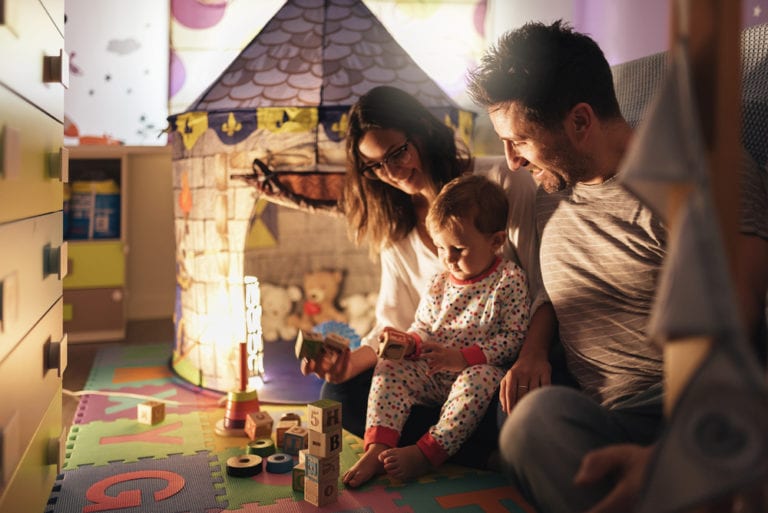How to Set Family Goals That Actually Stick: A Step-by-Step Guide
Disclosure: This post may contain affiliate links, meaning I may get a small commission if you decide to make a purchase through my links, at no cost to you.

Hey there, fellow parent! 😊 If you’re like me, achieving goals for your family can be tough. They often disappear quickly, like cookies at a school bake sale. You may wonder how to set family goals that actually stick. Well, let’s get started!
With my husband and our four kids, I’ve learned that good intentions aren’t enough. You need a solid plan that works! Research from the American Psychological Association shows that families who set goals together are 42% more likely to succeed than those who go it alone.
But, most families give up early because they lack the right plan. That’s why I made this step-by-step guide!
Whether you want to spend more time together, save for a dream vacation, or get everyone to help with chores, this guide will help. You’ll learn how to set family goals that change your daily life for the better.
Key Takeaways
- Families working together are 42% more successful at achieving their objectives than individuals
- Most families abandon their plans within the first month due to lack of proper framework
- Effective family goal planning requires a step-by-step system, not just good intentions
- This guide provides proven strategies that work for busy families with multiple children
- You’ll learn practical techniques to create lasting change in your household dynamics
Related:
How to Create a Goal Chart For Kids
Social Media Contract For Teens
10 Steps to Successful Family Meetings
Why Family Goal Setting Matters More Than Ever
Family goal setting is a powerful tool for bringing families together. It helps families feel connected and work towards common dreams. When everyone works together, amazing things happen!
Setting shared family priorities changed our lives. Before, my husband focused on work, I juggled everything, and our kids did their own thing. But planning together made a huge difference.

The Science Behind Successful Family Goal Achievement
Research on family goal setting is fascinating. Dr. Laurence Steinberg found that families who set goals together have 35% stronger emotional bonds and better communication.
Children from goal-oriented families do better in school and have higher self-esteem. It’s not just about achieving goals; it’s about the journey together.
Creating family objectives together rewires our brains for success. It builds strong family connections. This is pretty amazing!
How Family Goals Strengthen Relationships and Build Unity
When families work together, something beautiful happens. Everyone becomes invested in each other’s success. Your teenager’s achievement is celebrated by the whole family!

Working together, celebrating wins, and learning from setbacks creates lasting bonds. It builds a family culture where everyone matters. When we set shared priorities, we naturally support each other more.
Think of it this way: instead of living separate lives, you become a team with a mission. The daily chaos makes sense because everyone knows their role. Families start to thrive together!
The beauty of family goal setting is in creating meaningful objectives. It brings out the best in everyone and builds lasting memories.
Understanding Your Family’s Current Situation
You can’t build a roadmap to success without knowing your starting point as a family. Yes, with my husband and four kids, we kept setting the same goals year after year, wondering why nothing seemed to stick.
The truth is, we were trying to navigate without a compass. We had no idea what our family truly valued or where our real strengths lay. Once we took time to honestly assess our current situation, everything changed.

Conducting a Family Values Assessment
A family values assessment sounds intimidating, but it’s actually one of the most fun conversations you’ll have! We started with a family meeting and gathered everyone in our living room with snacks and asked simple questions like “What matters most to our family?”
The answers surprised me. While we all said we valued “family time,” we discovered we had completely different ideas about what that looked like. Our teenagers craved adventure and new experiences. Our younger kids just wanted more one-on-one attention with mom and dad.
Start with these basic questions during your family meeting and values assessment:
- What makes our family special?
- When do we feel happiest together?
- What traditions mean the most to us?
- How do we want others to see our family?
Write down everyone’s answers without judgment. You’re building the foundation for achieving family goals together that actually reflect what matters to your unique family.
Identifying Strengths and Areas for Growth
Every family has superpowers – you just need to identify them! Our family discovered we had an amazing sense of humor and incredible resilience during tough times. These became our secret weapons for achieving family goals together.

But we also had to face our growth areas honestly. We struggled with time management and often overcommitted ourselves. Recognizing this pattern helped us set more realistic expectations.
| Assessment Area | Questions to Ask | What to Look For |
|---|---|---|
| Communication | How well do we listen to each other? | Open dialogue, respect for different opinions |
| Time Management | Do we make time for what matters most? | Balance between activities and family time |
| Problem Solving | How do we handle challenges together? | Teamwork, support, creative solutions |
| Traditions | What brings us joy and connection? | Meaningful rituals, shared experiences |
Don’t skip the hard conversations. Growth happens when we acknowledge both our strengths and our struggles with equal honesty.
Recognizing Past Goal-Setting Patterns
Here’s where things get real – and really helpful! Look back at your family’s goal-setting history. What worked? What didn’t? And most importantly, why?

We realized our family movie nights always got derailed by homework and activities. Instead of feeling defeated, we used this information to design better goals that fit our actual rhythm.
Ask yourselves these revealing questions:
- What goals have we attempted before?
- Which ones succeeded and why?
- What obstacles consistently trip us up?
- How do we typically respond to setbacks?
This isn’t about dwelling on past failures. It’s about gathering valuable data for your family values assessment. When you understand your patterns, you can work with them instead of against them.
Remember, every family is different. What works for your neighbor’s family might not work for yours – and that’s perfectly okay! The goal is to understand your family’s unique dynamics so you can create goals that actually stick.
Establishing Family Mission Statements
Creating family mission statements might seem complex, but it’s simple. Just ask, “What kind of family do we want to be?” Our first try was chaotic! Four kids, my husband, and me all trying to contribute.

But that chaos led to something amazing. After three meetings and lots of pizza, we got our mission and vision: “We are a family that chooses love, laughter, and adventure in everything we do.”
Your mission statement should be easy for kids to remember. It should make everyone smile. Most importantly, it should be truly yours.
| Vision Statement Element | What It Includes | Example | Why It Matters |
|---|---|---|---|
| Core Values | What your family stands for | Kindness, honesty, fun | Guides daily decisions |
| Emotional Tone | How you want to feel together | Joyful, supportive, adventurous | Creates positive atmosphere |
| Future Direction | Where you’re heading as a unit | Growing closer, making memories | Provides long-term motivation |
| Action Words | What you commit to doing | Choose, create, celebrate | Turns vision into behavior |
How to Set Family Goals Using the SMART Framework
Using the SMART framework changed how my family sets goals. It turns vague wishes into clear plans. Smart family objectives make it easy for everyone to follow.
Instead of “We want to spend more time together,” we say “We will have device-free family dinner conversations for 30 minutes, four nights per week, starting this Monday.” This makes a big difference. Dominican University found that writing down specific goals increases success by 42%!
Making Goals Specific and Measurable
When goals are specific and measurable, success is clear. For example, “get healthier as a family” becomes “take a 20-minute family walk together three times per week for the next month.”
Being clear about what you want to achieve is key. Ask who, what, when, and how. Using numbers makes goals easier to track.
“Read more books together” becomes “read one chapter of our family book every Tuesday and Thursday evening.” Now we can see our progress!
Ensuring Goals Are Achievable and Relevant
Setting achievable goals is important. I learned this when we tried to cook dinner together every night. With four kids, it was impossible! Now we aim for three family cooking nights per week, and it works.
Goals should match your family’s values and situation. If you value creativity, try art or music. If health is key, aim for active goals like hiking.
Goals should be exciting but not overwhelming. Think of it like Goldilocks – not too easy, not too hard, but just right!
Setting Realistic Timeframes
Many families struggle with timeframes. Start small! A 30-day goal is manageable, while a year-long goal can be overwhelming.
Break big goals into smaller ones. Want to save for a vacation? Set a monthly target. Want to improve communication? Start with weekly meetings for a month.
Mastering 30-day goals leads to bigger achievements. Short wins build momentum for bigger dreams!
Step 1: Organize Your First Family Planning Meeting
Your first family planning meeting is where the magic begins. It might feel chaotic at first! Our first try was a disaster. Imagine four kids, snacks everywhere, and everyone talking at once.
But that mess taught us a lot about collaborative goal setting. The beauty of family meetings is bringing everyone together. Research shows families who meet regularly improve their communication and problem-solving by 23%.
Now, our family meetings are something we all look forward to. It didn’t happen overnight, but the right approach made a big difference.
Check out our Family Meeting Planner Here!
Preparing the Right Environment
The right environment is key to success. Our kitchen table is perfect for meaningful talks. It feels natural and comfortable.

I prepare snacks everyone loves. Hungry kids don’t make good collaborators. We keep it simple with crackers, fruit, and cookies.
Lighting a special candle signals “it’s family meeting time.” It’s a small ritual that helps everyone focus. No phones or TV, just us and our goals.
Choose a relaxed and alert time for meetings. Sunday afternoons work for us. Consistency is key once you find your rhythm.
Setting Ground Rules for Productive Discussions
Ground rules create a safe space for everyone to share. Our rules are simple: everyone gets to talk, all ideas are welcome, and we use kind words.
Without clear rules, meetings became debates. You can use a “talking stick” approach. Whoever holds the stick gets to speak while others listen.
We also don’t criticize during brainstorming. Creativity flows freely. This rule has led to innovative ideas in our meetings.
| Ground Rule | Purpose | Example in Action |
|---|---|---|
| One person speaks at a time | Ensures everyone feels heard | Using a talking stick or designated speaker |
| All ideas are welcome | Encourages creative thinking | Writing down even “silly” suggestions |
| Use kind words | Maintains positive atmosphere | Saying “I see it differently” instead of “That’s wrong” |
| Stay focused on goals | Keeps discussion productive | Gently redirecting off-topic conversations |
Step 2: Brainstorm Meaningful Family Objectives
Starting to brainstorm family goals is like going on a treasure hunt for new ideas. It’s where the excitement really starts! The best family goal setting strategies come from dreaming big and sharing all ideas.
It’s important to create a space where everyone can be creative. No idea is too crazy or too big. We’re building the foundation for goals that will really motivate your family.
Techniques for Generating Ideas Together
I love the “Dream Board” technique. You can use magazines, colored paper, and markers on the dining table. Everyone makes a visual of what they want for our family.
This brings out amazing ideas! Our kids have suggested things like “learn to make pizza from scratch together” and “visit every state park in our area.” It’s fun for kids and sparks creativity in adults too.
Another great method is the “Round Robin” brainstorming session. Each person shares one idea while others listen without judging. We keep going until we run out of ideas.
The “What If” game is also a favorite. We ask questions like “What if we had unlimited time this summer?” or “What if we could learn any skill together?” It opens up creative thinking and reveals hidden desires.
Categorizing Goals by Priority and Timeline
You can use the “parking lot” method to organize ideas. We write every suggestion on sticky notes and sort them into three categories.
The categories are “Do This Month,” “Do This Year,” and “Dream Big Goals.” This helps us see what’s realistic and what needs more planning.
Research from MIT shows diverse brainstorming leads to 35% more innovative solutions. The same is true for families! When everyone shares their unique perspective, you get goals that really reflect your family’s personality.
When sorting, we also think about resources and the season. Beach goals fit summer, while indoor learning is better in winter.
Step 3: Develop Short-Term and Long-Term Family Achievements
Now, let’s turn those ideas into a timeline that fits your family’s busy schedule! The secret to lasting success is balancing quick wins with long-term family achievements. Each small success boosts your confidence and prepares you for bigger challenges.
By celebrating small wins, your family stays motivated and engaged. Studies show that breaking big goals into smaller steps increases success by 90%.
“Success is the sum of small efforts, repeated day in and day out.”
Creating 30, 60, and 90-Day Milestones
Your short-term family goals lay the groundwork for bigger achievements. Starting with 30-day goals is great because they’re easy but impactful. Last month, we focused on “gratitude sharing” at dinner.
It changed our dinner talks! The kids loved sharing, and we all noticed more good things in our lives.
For 60-day goals, we commit to something a bit bigger. This might be organizing a family service project or learning a new skill. Our 90-day goals are even bigger, like training for a family 5K or planning a special trip.
| Timeline | Goal Type | Example | Success Measure |
|---|---|---|---|
| 30 Days | Daily Habits | Family gratitude sharing | Everyone participates 5+ times weekly |
| 60 Days | Skill Building | Learn cooking together | Master 3 new family recipes |
| 90 Days | Project Goals | Plan family camping trip | Complete trip with positive memories |
| 12 Months | Major Achievement | Strengthen extended family bonds | Host 4 family gatherings successfully |
Planning Annual Family Objectives
Annual goals are where we dream big and aim for long-term family achievements. These might include strengthening family bonds or improving financial literacy. The key is to make these goals exciting and achievable for everyone.
Annual goals work best when they focus on relationships, growth, or experiences. Our family’s goals often aim to become closer, learn together, or help our community.
Connecting Short-Term Wins to Long-Term Vision

Every short-term goal should link to your long-term vision. When our kids see how learning to cook (our 30-day goal) helps our annual goal of becoming more self-sufficient, they get it.
This strategy keeps everyone motivated, even when things get tough. We talk about how our daily actions add up to something big. It’s like showing kids how each puzzle piece fits into the final picture.
Seeing patterns and celebrating progress together is truly magical!
Step 4: Create Your Family Goal Worksheet and Action Plans
Creating a family goal worksheet is more than just organizing. It’s about making a visual guide that keeps everyone excited. We’ve found that making goals clear and trackable is key. The best systems mix looks good with being useful.
Finding the right system for your family is crucial. Some like digital apps, while others prefer physical charts.
Designing a Visual Goal Tracking System
Your tracking system should grab everyone’s attention! We use a big whiteboard in our kitchen for monthly updates. Each person has their own color of magnets to track their tasks.
This visual system boosts motivation. Seeing others succeed motivates my kids to do the same. We also keep a journal to record our achievements and lessons learned.
| System Type | Best For | Maintenance Level |
|---|---|---|
| Kitchen Whiteboard | Daily visibility | Low |
| Digital Apps | Tech-savvy families | Medium |
| Poster Charts | Young children | Low |
| Family Binder | Detailed tracking | High |
Assigning Roles and Responsibilities
Every family member should have a role in reaching goals. It’s not just mom’s job! Even our youngest can be the “encouragement captain” or help plan celebrations.
Teenagers often do well when leading goals they care about. Your 15-year-old cand lead fitness goals, and your 8-year-old tracks kindness efforts.
Studies show that clear roles lead to better success. Make sure everyone knows their part and how it helps the family.
Setting Up Accountability Measures

Accountability should feel supportive, not scary. Our system includes weekly dinners, monthly celebrations, and quarterly reviews.
We focus on successes, not failures. When someone struggles, we solve problems together. This keeps everyone motivated and avoids blame.
Consistency is key. Regularly review progress, celebrate, and adjust as needed. Remember, it’s about making progress, not being perfect!
Engaging Toddlers and Preschoolers (Ages 2-5)
Little ones live in the moment. So, effective family goal setting strategies for them need to be immediate and visual. Everything should be simple, colorful, and fun!
We used picture charts with our youngest ones. Instead of saying “clean up toys,” we draw pictures of toys going into bins. Our youngest loved putting star stickers on her chart when she completed her “special job.”
Simple goals are best for this age. “Help put toys away” or “try one new food this week” are great starting points. Giving each little one a unique family role makes them feel important.
Our youngest became our official “hug giver” during family meetings. When someone feels frustrated, she gives the biggest hug! It’s adorable and helps everyone reset their emotions.
Immediate rewards are key. Sticker charts, high-fives, and celebration dances keep preschoolers engaged. We celebrate every small win with enthusiasm that matches their energy level.
Motivating School-Age Children (Ages 6-12)
This age group is perfect for family goal setting! School-age children understand cause and effect, love earning privileges, and can handle more complex objectives.
When our oldest wanted a new bike. Instead of just buying it, we created a family savings goal where everyone contributed. Learning about money became a family adventure!
Point systems work well with this age group. We assign points for completing family goals, and kids can “spend” points on special privileges like choosing the family movie or staying up thirty minutes later on weekends.
Charts and visual tracking systems appeal to their developing organizational skills. Our olde3st daughter designed her own goal tracker with colorful markers and decorative borders. She takes pride in updating it weekly.
School-age children also love goals that connect to their personal interests. When our son became obsessed with baseball, we created family fitness goals that included throwing practice in the backyard.
Including Teenagers in Goal Planning
Teenagers need to feel like partners, not participants. They want goals that respect their growing independence while still connecting them to family values.
Our teenagers helped facilitate family meetings. They led discussions about long-term planning and often suggested goals that challenge the whole family. This shift from participant to leader has been amazing to watch!
Related
Research from the Search Institute shows that adolescents who participate in collaborative goal setting show 40% higher levels of family satisfaction and personal responsibility. We’ve definitely seen this in our own home.
Teenagers respond well to goals that prepare them for adulthood. Financial literacy, time management, and leadership skills become natural family goal topics. Our teens have suggested we all learn a new skill.
Give them real decision-making power. When planning our family vacation, our teenager researched destinations, compared costs, and presented options to the family. She felt valued and we got an amazing trip!
The secret is treating them as the young adults they’re becoming. Ask for their opinions, respect their ideas, and show them how family goals can support their individual dreams.
Remember, what works for one child might not work for another, even within the same age group. Stay flexible and adjust your approach based on each child’s personality and interests. The goal is creating a system where everyone feels heard, valued, and excited about working together!
Implementing Collaborative Goal Setting Techniques

Setting goals is just the start. The real magic happens when families work together to achieve them. I’ve seen many families get excited about their goals, but then lose interest. The difference between success and failure is how well you use collaborative goal setting to keep everyone motivated.
Creating structured approaches makes goal achievement enjoyable. When families work together, they build stronger bonds and make progress toward their vision.
Regular Family Check-Ins and Progress Reviews
Our family changed when we started weekly “Sunday Success Sessions.” These 20-minute talks were a favorite tradition! Everyone shares their wins, challenges, and what they need for the next week.
These check-ins keep us connected and accountable without feeling like homework. We’ve had hot chocolate, and everyone got a turn to share. Even our youngest feels important when she talks about her goals..
Regular reviews help solve small problems before they become big ones. When my teenager struggled with his study schedule, we adjusted it together. This family purpose planning approach helps prevent goals from causing stress.
Celebrating Milestones and Small Wins
Research from Harvard Business School shows teams that celebrate small wins are 31% more productive. The same is true for families! Celebrations don’t have to cost money or take a lot of time.
We love celebrating with family dance parties, homemade cakes, special movie nights, or just high-fives. When my daughter reached her reading goal, we had a “book party” where everyone dressed up.
The key is to celebrate progress, not just completion. This keeps motivation high and shows kids that effort is important.
Adjusting Goals Based on Changing Circumstances
Life changes, and successful goal setting requires flexibility. When my husband’s work schedule changed, we adjusted our “family dinner four nights a week” goal. We changed it to “family breakfast twice a week plus weekend dinners.”
This adaptability teaches kids valuable life skills like resilience and problem-solving. Instead of giving up when things change, we ask how to adapt our goals. This keeps everyone invested and prevents disappointment.
Overcoming Common Family Goal-Setting Obstacles
Family goal setting can be tough! After years of working with my four kids, I’ve seen every obstacle. But these challenges are stepping stones to stronger family bonds and better goal-setting skills.
When we first started, our teenagers would dramatically sigh at family meetings. Our middle child would suddenly have “selective hearing” when we talked about fitness goals. Sound familiar?
Obstacles are part of the journey. Research shows families who discuss their challenges develop 45% better resilience skills. Let’s explore the most common hurdles and practical solutions that work!
Dealing with Resistance and Lack of Motivation
Motivation for kids and families can be a challenge. Resistance is also big challenge for families. It can show up as eye-rolling or a sudden “I don’t want to do this anymore” declaration.
Resistance often isn’t about the goal itself. It’s about feeling unheard, overwhelmed, or disconnected. When our daughter resisted our reading goal, I got curious instead of frustrated.
I asked her, “What would make this more interesting for you?” She wanted to read for as long as she wanted without interruption. That small adjustment reignited her enthusiasm completely!
The key is to get curious, not critical. Try these questions when you hit resistance:
- “How can we adjust this goal to work better for you?”
- “What part feels most challenging right now?”
- “What would make this more fun or meaningful?”
Sometimes the solution is as simple as changing the timing, location, or format of your goal activities.
Managing Conflicting Schedules and Priorities
Modern family life is busy! Finding time for family goals can feel impossible. I used to stress about this until I realized connection matters more than perfection.
Our family goal setting strategies had to evolve with our crazy schedules. Our “family reading time” moved to car rides. Our weekend hiking goal became “adventure walks” around the neighborhood when we didn’t have time to drive to a destination.
The secret is flexibility and creativity. Look for small pockets of time throughout your day. Even five minutes of focused family time can make a difference when it’s consistent.
Here are some schedule-friendly adaptations that work:
- Turn car rides into goal time (audiobooks, gratitude sharing, planning discussions)
- Use meal prep time for family conversations about progress
- Create “micro-goals” that take 10 minutes or less
- Stack new habits onto existing routines
Handling Setbacks and Disappointments
Setbacks happen to every family. We failed to meet our “screen-free Sunday” goal for three weeks straight. Our savings goal got derailed by an unexpected car repair.
Initially, I felt like these setbacks meant we were failing as a family. But I learned that disappointments are incredible teaching opportunities. They show us what’s realistic, what needs adjusting, and how to bounce back together.
Now we celebrate “learning moments” just as much as we celebrate successes. When something doesn’t work, we ask:
- “What did we learn about ourselves?”
- “How can we adjust our approach?”
- “What worked well, even if we didn’t reach the full goal?”
This mindset shift has made our family more resilient and honest about our challenges.
| Common Obstacle | Why It Happens | Practical Solution | Success Tip |
|---|---|---|---|
| Teen resistance | Feeling controlled or unheard | Give them leadership roles in goal planning | Ask for their input on family meeting format |
| Schedule conflicts | Over-ambitious timing expectations | Build goals into existing routines | Start with 5-minute daily commitments |
| Lost motivation | Goals feel too big or abstract | Break into smaller, weekly milestones | Celebrate small wins immediately |
| Perfectionism pressure | All-or-nothing thinking | Focus on progress, not perfection | Track effort, not just outcomes |
Remember, every family faces obstacles when working toward goals together. The difference between families who succeed and those who give up isn’t the absence of challenges – it’s how they respond to them.
When you hit a bump in the road, take a deep breath. Get curious about what’s really happening. Adjust your approach if needed. And most importantly, keep the focus on connection and growth rather than perfect execution.
These obstacles aren’t signs that your family isn’t cut out for goal setting. They’re normal parts of the journey that make your family stronger, more flexible, and more united in the long run!
Tools and Resources for Family Purpose Planning
After trying many methods, I found the best family goal worksheet and tools are simple. It’s not about the most advanced system. It’s about finding tools your family will use every day.
Many families get excited about new apps but soon lose interest. The key is finding a balance between technology and hands-on activities. This keeps everyone motivated and engaged.
Digital Apps and Platforms for Goal Tracking

Let’s talk about digital tools that work for busy families. Cozi has been our favorite family calendar app for three years. It helps keep track of goals and stay organized with shared shopping lists.
Google Family Calendar is also great, especially if you use Google products. It lets each family member have their own color for tracking goals. Kids love it!
For simple tracking, try Todoist or a shared Google Doc. These tools help you make checklists, set reminders, and celebrate goals. Keep it simple when kids are involved – it’s more effective!
Physical Tools and Visual Aids
Our kitchen command center is where the magic happens! It has a large whiteboard for monthly goals. It’s the heart of our family purpose planning system. Seeing your goals every day is powerful.
One favorite tool is the “goal thermometer” poster. It shows our progress toward big goals like saving for vacation. Seeing the colors fill in motivates everyone and sparks conversations about our dreams.
Don’t forget about an achievement jar! You can write down small wins and goal completions. Reading these during family meetings reminds us of our accomplishments.
Creating Family Traditions Around Goal Achievement
Creating memorable moments is key! Consider having a “Goal Celebration Dinner.” Each family member chooses something special – the menu, decorations, or activity.
We take a family photo every time we reach a major goal. These photos are treasured and remind us of our achievements.
Research shows families with traditions are 60% happier and have stronger bonds. Combining goal-setting with celebration creates lasting memories.
Maintaining Momentum and Long-Term Success
Keeping family goals alive isn’t about being perfect. It’s about making habits that grow with your family. Many families start strong but lose steam after a few months. The secret to long-term family achievements is creating systems that change as your family does.
Families who keep succeeding year after year know a key secret. Momentum isn’t about always moving. It’s about regular check-ins, flexible plans, and celebrating small wins. When we focus on building lasting habits, everything changes!
Evolving Goals as Your Family Grows
I wish someone had told me earlier: your goals should grow with your family. What worked when our kids were young doesn’t work now that they’re older.
Regularly assessing your family values is crucial. Every year, we check if our values still match who we are. Sometimes we find new priorities, and sometimes we realize old goals don’t fit anymore.
The key is to stay flexible while keeping your core values strong. We see these changes as chances to grow closer, not as obstacles.
Building Goal-Setting as a Lifelong Family Habit
Teaching children to set and achieve goals is a great gift. Studies show that kids who learn goal-setting skills do better in life.
We’re not just chasing long-term family achievements. We’re building character and skills that last a lifetime. When they leave home, they’ll carry these habits with them.
The habits we’re building now will affect generations to come. That’s the true power of family goal setting!
Conclusion
What an incredible journey we’ve shared together! Learning how to set family goals has been rewarding. When I first started planning goals with my husband and kids, I didn’t know how much it would change us.
The magic isn’t in the goals themselves. It’s in creating a culture where everyone feels heard and valued. It’s about teaching kids that their dreams matter and that planning makes them possible.
You don’t need to be perfect to begin. Our best moments came from messy planning meetings! The secret is starting where you are. Gather your family this week for that first conversation.
Every family’s path is different, but the goal is the same: stronger bonds and joy in achieving together. Your family has everything needed to succeed.
Take that first step today. Schedule your family meeting, grab some snacks, and start dreaming together. The adventure of family goal planning begins with your courage to try!
FAQ
How often should we hold family planning meetings to set and review our goals?
What’s the best way to get reluctant teenagers involved in family goal setting?
How do we create smart family goals that work for different age groups?
What should we do when our family consistently fails to meet our goals?
How can we balance individual family members’ interests with collective family priorities?
What tools work best for tracking family goals with young children?
How do we maintain momentum when life gets busy and chaotic?
Should we focus more on short-term family goals or long-term objectives?
How can we celebrate family goal achievements without spending a lot of money?
What’s the difference between family values assessment and goal setting?
GET FREE ACCESS TO OUR LIBRARY OF FREE PRINTABLES AND RESOURCES!
Enter Your Name and Email for FREE Access to our Library of FREE Home and Family Printables Series!





